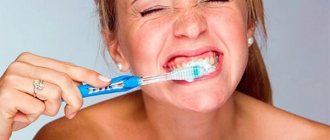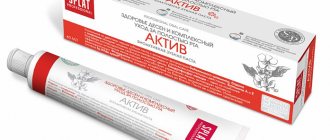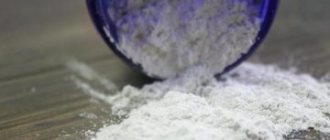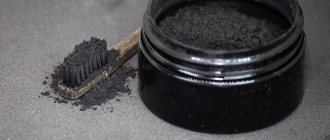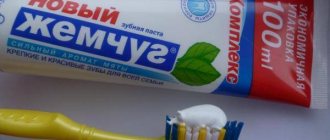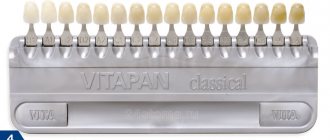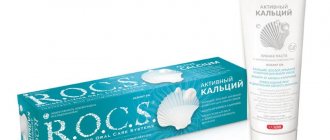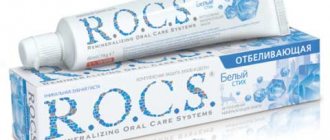Oral hygiene is important!
And the first thing that daily oral hygiene is associated with today is brushing your teeth.
and, of course, toothpaste. Although quite recently our grandmothers used dental cleaning powder. With the advent of toothpaste, the powder was forgotten. And now supporters of the powder method of brushing teeth are again appearing.
And here is the dilemma: what is healthier, tooth powder or toothpaste
?
The debate between supporters of one and the other method has been going on for a long time. Everyone defends their opinion.
From TV we hear every day about effective toothpastes, but almost no advertising for tooth powder. And this does not mean that the powder is ineffective.
Tooth powder or toothpaste - the choice is yours. But be sure to consult your dentist.
Purpose
It should be noted that at that time the purpose of tooth powder was not to prevent caries or treat periodontitis. At that time they did not even know such words, did not understand the reasons for their occurrence, and therefore could not yet contain these diseases with hygienic means. The main and only goal was to cleanse the teeth of plaque and tartar. Please note: in the first half of the 20th century, dentists had not yet performed such a now widespread procedure as professional oral hygiene. Neither ultrasonic nor air-abrasive (Air-Flow) treatment had yet been invented. The only way to remove conspicuous plaque is to clean it yourself.
Evolution
The appearance of the first tooth powder dates back to the 2nd century BC. e.. Then the product was made from crushed shells, corals, pumice, eggshells and animal bones. Such a drug could not boast of a soft effect, and severely scratched the enamel.
Over time, the composition of the powder changed: chalk and mint or anise oil were used as the main element.
The modern product is made from precipitated calcium carbonate and various additives that strengthen the enamel and prevent periodontal disease.
Starting line-up
Therefore, a good century-old tooth powder is one that has excellent abrasive properties. Hence they added to it: pumice, sand, ground bones, eggshells, mollusk shells, broken bricks and God knows what else. It must be said that toothpastes of those times were in no way behind powders in terms of abrasiveness. Moreover, to help a good cause, individual inventors added acids and alkalis of varying degrees of aggressiveness to them. Well, of course - after all, tartar softened by acid is easier to remove (alkali has not proven its worth in this regard). In general, the evolution of hygiene products has moved towards clearly expressed aggressiveness.
Dentifrice
The ideal base for the powder is ground chalk; in each area, gypsum, egg shells, sea shells and corals were used. Then they learned to precipitate chalk chemically and enrich it with magnesium carbonate. It became less abrasive and did not wear off the enamel. Oils (mint, anise, clove) were added to the powder to flavor them. White clay is used for the base, supplemented with volcanic tuff and sea minerals.
The powder cleanses the enamel and prevents the formation of tartar and the development of caries. There are powder products with a whitening effect in pharmacies; with regular use, you can achieve whitening of teeth by removing coffee and tobacco deposits.
The powder, diluted to a thick paste, can be applied to the teeth and held for 10-15 minutes to obtain a lightening effect. Such applications are useful for inflammation and bleeding gums. If you have problems with your gums, it is not advisable to use the powder so as not to injure them. Rubbing the surface of teeth with dry powder is not recommended; it can damage the enamel. Doctors recommend using a product with lightening microgranules and soda 1-2 times a week. On other days, use toothpaste.
To read: Periodontal diseases
Advantages. The powder removes food debris, plaque and tartar, whitens and polishes enamel, has a beneficial effect on the gums (massages), and helps normalize the acid-base balance in the mouth.
Do you feel nervous before visiting the dentist?YesNo
Flaws. It is not easy to introduce healing additives into the dry powder form of the product. Frequent use of powder can lead to damage to the integrity of the enamel due to its abrasive properties. Inconveniences of use: the powder is volatile, easy to scatter, does not have a dispenser or sealed packaging. Do not dip a wet toothbrush into a box of dry toothbrush. This degrades its quality and the risk of bacterial growth. You need to scoop up the powder with a dry spoon and transfer it to a brush (you can dilute it with water in a spoon). It will be more convenient to use if you pour it into a closed container.
In the haberdashery departments of stores you can purchase powder products (“Metro”, “Pearl”, “Mint”, “Moidodyr”, “Children’s”, “Osobyi”, “Smayda”) with teeth-cleaning and breath-freshening properties. It is not recommended for use by people with worn, damaged enamel, tooth sensitivity, or dental diseases (gingivitis, periodontal disease, stomatitis).
To prevent the enamel from being worn away, the powder can be used twice a week to clean plaque on teeth and prevent the formation of tartar. Cleaning time up to 3 minutes.
After brushing your teeth, you should rinse your mouth especially thoroughly and use mouthwash.
Harm
But in 1907, an outstanding article was published in The Dental Cosmos: Miller WD. Experiments and observations of the wasting of tooth tissue variously designated as erosion, abrasion, chemical abrasion, denudation, etc. It had about the same impact on dentists as Albert Einstein’s “On the Electrodynamics of Moving Bodies,” published two years earlier, had on physicists. Equipped with terrifying illustrations, it clearly demonstrated the monstrous abrasion of teeth (in vitro) with pastes and powders. Here's one example:
Quality improvement
Of course, not all dentists read this study. Consumers of the powder certainly had no idea about it. Therefore, it took decades before highly abrasive components began to be abandoned. Such useful indicators as RDA (relative dentin abrasivity) and REA (relative enamel abrasivity) were introduced. The lower they are, the less the teeth wear out. Today, manufacturers who respect their customers indicate digital RDA values on each tube. Less than 70 – low abrasiveness, 71-100 – moderate, 101-150 – high, 151-200 – very high. Here is the RDA table for some modern pastes:
| Toothpaste name | RDA | Toothpaste name | RDA |
| Toothbrush with plain water | 4 | Colgate Sensitive Max Strength | 83 |
| Regular baking soda | 7 | Aquafresh Sensitive | 91 |
| Weleda Salt Toothpaste | 15 | Sensodyne Cool Gel | 92 |
| Elmex Sensitive Plus | 30 | Rembrandt Plus | 94 |
| Sensodyne ProNamel | 34 | Sensodyne Fresh Impact | 94 |
| Arm & Hammer Dental Care | 35 | Sensodyne Original | 100 |
| Weleda Calendula Toothpaste | 45 | Sensodyne Extra Whitening | 104 |
| Weleda Ratanhia Toothpaste | 45 | Sensodyne Full Protection Whitening | 107 |
| Arm & Hammer Dental Care Sensitive | 48 | Aquafresh Whitening | 113 |
| Tom's of Maine Children Toothpaste | 57 | Lacalut White | 120 |
| Colgate Sensitive Enamel Protect | 63 | Colgate Total Whitening | 142 |
| ClinPro | 65 | Colgate Total Advanced Fresh | 160 |
| Colgate Regular | 68 | Colgate Tartar Control | 165 |
| Colgate Total | 70 | Colgate 2-in-1 Tartar Control/Whitening | 200 |
| Colgate Fresh Mint | 70 | President White Plus | 200 |
Modern composition
So, coarse abrasives were disqualified from the contents of tooth powder. But what is there now? Soda, as can be seen from the table, has minimal harmful qualities. It is harmless, but its effectiveness is low. It weakly cleans plaque and does not “take away” tartar at all. Its hardness on the Mohs scale is 2.5. That's why the main ingredient in today's tooth powders is chalk (calcium carbonate). Its hardness on the Mohs scale is 3. It cleans teeth relatively gently and is more effective than soda. The rest is fragrances, flavor enhancers, dyes, etc.
Popular brands
Blend-a-med PRO-EXPERT effectively removes plaque, freshens breath, protects against caries and tartar, and reduces tooth sensitivity. Contains polyphosphates and stabilized tin, which have a beneficial effect on the condition of teeth and gums: strengthens and gently whitens the enamel.
To read: How long can you walk with a temporary filling?
The German paste Lacalut is recommended for adults and children, which prevents the deposition of tartar, strengthens gums, and freshens breath.
International offers Colgate paste with a different set of medicinal herbs, anti-inflammatory, whitening, enamel strengthening effect,
“Forest balm”, as well as rinses based on medicinal herbs, with aloe vera, for various purposes, depending on the composition of medicinal plant components, are recommended for oral care and the prevention of dental problems.
Popular among consumers:
- Aquafresh,
- Paradontax,
- New pearls
- Splat Professional Active (does not contain fluorine).
The final victory of toothpaste
Back in 1914, there were attempts to introduce fluoride into toothpaste. But only after large-scale research in the early 1950s, which proved the effectiveness of fluoride toothpastes, did active commercial production begin. The pioneer was Procter & Gamble with Crest toothpaste. Then the rest of the manufacturers picked up the baton. In addition to fluorides (to prevent caries), antiseptics and anti-inflammatory components (to fight gingivitis), and desensitizing substances (to reduce dental hyperesthesia) began to be added to the paste.
Clinical researches
Asept products have proven effectiveness. For example, clinical studies have proven that regular use of professional toothpaste ASEPTA GENTLE WHITENING for a month allows you to lighten tooth enamel by 1.5 tones, increases anti-caries effectiveness by 3.4 times and increases enamel remineralization by 2.6 times.
Sources:
- Report on determining/confirming the preventive properties of toothpaste “ASEPTA PLUS” GENTLE WHITENING” Author: doctor-researcher A.A. Leontyev, head Department of Preventive Dentistry, Doctor of Medical Sciences, Professor S.B. Ulitovsky First St. Petersburg State Medical University named after. acad. I.P. Pavlova, Department of Preventive Dentistry
- Clinical and laboratory assessment of the influence of domestic therapeutic and prophylactic toothpaste based on plant extracts on the condition of the oral cavity in patients with simple marginal gingivitis. Doctor of Medical Sciences, Professor Elovikova T.M.1, Candidate of Chemical Sciences, Associate Professor Ermishina E.Yu. 2, Doctor of Technical Sciences Associate Professor Belokonova N.A. 2 Department of Therapeutic Dentistry USMU1, Department of General Chemistry USMU2
- Report on the determination/confirmation of the preventive properties of personal oral hygiene products “ASEPTA PLUS” Remineralization doctor-researcher A.A. Leontyev, head Department of Preventive Dentistry, Doctor of Medical Sciences, Professor S.B. Ulitovsky First St. Petersburg State Medical University named after. acad. I.P. Pavlova, Department of Preventive Dentistry
- Clinical studies of antisensitive toothpaste “Asepta Sensitive” (A.A. Leontyev, O.V. Kalinina, S.B. Ulitovsky) A.A. LEONTIEV, dentist O.V. KALININA, dentist S.B. ULITOVSKY, Doctor of Medical Sciences, Prof. Department of Therapeutic Dentistry, St. Petersburg State Medical University named after. acad. I.P. Pavlova
- The role of anti-inflammatory rinse in the treatment of periodontal diseases (L.Yu. Orekhova, A.A. Leontyev, S.B. Ulitovsky) L.Yu. OREKHOVA, Doctor of Medical Sciences, Prof., Head of Department; A.A. LEONTIEV, dentist; S.B. ULITOVSKY, Doctor of Medical Sciences, Prof. Department of Therapeutic Dentistry of St. Petersburg State Medical University named after. acad. I. P. Pavlova
- Report on determining/confirming the preventive properties of toothpaste “ASEPTA PLUS” COFFEE and TOBACCO Author: doctor-researcher A.A. Leontyev, head Department of Preventive Dentistry, Doctor of Medical Sciences, Professor S.B. Ulitovsky. First St. Petersburg State Medical University named after. acad. I.P. Pavlova, Department of Preventive Dentistry
- Report on determining/confirming the preventive properties of commercially produced personal oral hygiene products: Asepta toothpaste used in combination with Asepta mouthwash and Asepta gum balm Head. Department of PFS Doctor of Medical Sciences Professor S.B. Ulitovsky St. Petersburg State Medical University named after Academician I.P. Pavlova. Faculty of Dentistry. Department of Preventive Dentistry.
Where in the world is it used?
In developed countries, tooth powder is not produced. The last known global leader in the hygiene industry, Arm & Hammer, ceased sales in 2000. In Russia, tooth powder is used by 23% of the population. A recent study was conducted in India in 2022: it was found that 31% of rural residents and 15% of urban respondents use tooth powder. A strong relationship has been found between the use of tooth powder and abrasion of tooth tissue, bleeding and gum recession. This is the “beauty” you get after consuming Indian tooth powder:
How to brush your teeth correctly
Please note that despite the fact that most of the Indian tooth powder fan's own enamel has been erased, the black plaque has not been cleaned out everywhere. And this is on the front surface - you can imagine how much worse the situation is on the internal surfaces. This happens because brushing your teeth requires, first of all, not strength, but intelligence. Instead of violent movements, moderate but frequent movements are needed. Not horizontal, but vertical, sweeping. From the gum to the tooth: from bottom to top - on the lower jaw, from top to bottom - on the upper jaw. And, naturally, you need to brush your teeth not only on major holidays, but every day. Then the soft plaque will not yet have time to calcify and stick firmly to the enamel.
Features of use
For tooth powder, the instructions for use are a little more complicated than for toothpaste. The toothbrush should be moistened with water and the wet bristles should be dipped into a jar of powder. It is advisable to immediately collect a portion for the entire one-time cleaning. After all, when re-sampling, microorganisms will get into the powder. Bacteria, by the way, will still end up in the jar (unless you use disposable brushes), because they remain on the fibers from the previous cleaning. But in the 12 hours that have passed since the last hygiene procedure, most of the microbes have already died and do not pose any danger to the owner. The same cannot be said about other members of the family. Therefore, everyone should have a personal jar of tooth powder - otherwise there is a high risk of infecting close relatives. This is another inconvenience compared to toothpaste - the whole family can use a common tube.
Reviews
Why then are there such a huge number of positive reviews about tooth powder on the Internet and among friends? It’s not surprising - there are also a lot of words of praise about homeopathy and osteopathy. Valerian, Actovegin, Linex and a hundred or two other ineffective drugs find no less devoted admirers. A person is such an amazing creature that, having convinced himself of the usefulness of a particular drug, he can actually achieve a positive effect, even if this drug is an absolute dummy. This is called the placebo effect. After persistent self-hypnosis, the transition to truly more effective therapeutic and prophylactic agents is often met with hostility. Plus, irreversible negative consequences do not occur immediately. They include, among other things, the absence of a positive impact (prevention of diseases), which few fans think about.
LiveInternetLiveInternet
We all brush our teeth several times a day every day. For most people, this process is no longer possible without the use of some kind of toothpaste, the variety of which is currently very large.
How often have you thought about what substances are in the toothpaste that you use day after day, month after month? Probably the same as me - never. One day, a person very close to me recommended that I try using Microbright tooth powder instead of toothpaste. The effect amazed me, a pleasant feeling of freshness and cleanliness in the mouth, in a fairly short period of time (just a week) and I noticed that my teeth became much whiter, and the most important thing is the feeling during the teeth-brushing procedure, there is no more hated foam in my mouth! But I was wondering if using tooth powder is harmful to tooth enamel? I decided to look for something on this topic on the Internet. And what was my surprise, it turns out that brushing your teeth with tooth powder is not only useful, but also safe for life, which cannot be said about toothpastes. As it turned out, most toothpastes contain the following basic chemical elements: triclosan, fluoride, sodium lauryl sulfate. And all these components are far from safe for human health.
Triclosan – used as an antibacterial additive. In addition to harmful bacteria, it also destroys useful ones, which can cause dysbacteriosis. Triclosan is especially harmful to pregnant women. It can interfere with blood flow to the uterus, which causes oxygen starvation of the fetus.
Fluorine is a chemical element (“fluoros” is translated as “destructive”) and is classified as a toxic substance. When there is an excess of it in the body, phosphorus-calcium metabolism is disrupted. This has been proven by many studies. excess fluoride gets directly onto the tooth, . First, white spots appear on the teeth, then they turn yellow and then the tooth enamel is destroyed. It turns out that fluoride accumulates not only in teeth, but also in bones. It can change the structure of bone tissue, even causing bone cancer. Fluoride compounds have the most significant effect on the thyroid gland. Fluorine, like Iodine, is a halogen. Anyone who understands chemistry even a little knows that any halogen with a lower atomic weight replaces halogens with a higher atomic weight within its group in compounds. As is known from the periodic table, Iodine has a higher atomic weight than Fluorine. It replaces iodine in digestible compounds, thereby causing iodine deficiency. Chlorine, which is widely used for water purification, has the same properties, but it is less active than fluoride in chemical terms. A person has enough fluoride in his life, which he consumes along with apples, mineral water, tea and other products.
The most dangerous substance, which is part of 90% of toothpastes, is not fluoride, which has been talked about lately, but a foaming substance - sodium lauryl sulfate. Most often it is denoted by three Latin letters SLS or Cyrillic - PAV. It is this substance that, when it enters the oral cavity, foams and destroys plaque from tooth enamel. Lauryl and sodium lauryl sulfate penetrate and accumulate in various organs. They cause poisoning, eye diseases and cancer. Sodium lauryl sulfate dries out the oral mucosa, increases the sensitivity of the gums to allergens and irritants such as food acids, and is a strong abrasive, which leads to thinning of the enamel. The harm of toothpaste with SLS is also confirmed by ophthalmological studies: after using a toothpaste containing sodium lauryl sulfate, vision deteriorates by 5%. It turns out that the less foam, the better the quality of the toothpaste. The inscription SLS free means that the paste contains no foaming substance.
And that's not all the harmful chemicals contained in toothpastes!
Sorbitol , a liquid that keeps the paste from drying out, is a laxative and can cause diarrhea in children.
Paraffin - a substance derived from oil is responsible for making the paste look beautiful when squeezed out, but can cause pain in the abdomen and vomiting.
Formaldehyde negatively affects human genetics, respiratory organs, quality of vision and skin condition. Constant intake of small amounts of formaldehyde into the body can cause damage to the liver, kidneys and other pathological conditions.
The harm of toothpastes to humans is obvious!
Tooth powders were the only means of cleaning teeth before the advent of toothpaste. Initially, they were made on the basis of chalk, fine salt, and ground eggshells into powder. Tooth powder almost never contains chemical additives (foaming agents, dyes, surfactants), which are often added in large quantities to toothpastes.
Microbright Whitening Tooth Powder , with the refreshing mint flavor I mentioned at the beginning of my article, is the world's first antioxidant tooth powder containing Microhydrin from RBC (a Coral Club product).
Microbright tooth powder whitens teeth without the use of harsh abrasives and refreshes as well as cleans.
Microhydrin creates an alkaline environment in the oral cavity, which, by neutralizing acids and reducing surface tension, prevents the formation of plaque, tartar and bad breath, and reduces the processes of lipid peroxidation in the oral cavity.
Xylitol is a natural saccharide of plant origin that prevents the development of caries. It activates the process of remineralization, inhibits the growth of pathogenic microflora that causes caries and gum disease.
Aloe vera relieves irritation and inflammation of the exposed roots of teeth and gums, promoting their healing.
Menthol provides an analgesic, bactericidal and mild cooling effect, soothing the site of injury, improves blood circulation in the gums, and freshens breath for a long time.
After I tried this tooth powder myself, I decided - no more toothpastes, only Microbright!
If anyone is interested in Microbright tooth powder, write, I’ll tell you where and how to buy it.
Series of messages “Health and Beauty”:
Healthy lifestyle standards. Currently, there are no officially accepted norms as norms for a healthy lifestyle. The concept of a “healthy lifestyle” changes dynamically over time and this is not surprising. Humanity does not stand still; new results of research into our body, its capabilities and needs are emerging. New drugs are appearing that allow us to prolong health and youth.
Part 1 - The healing properties of hydrogen peroxide Part 2 - Healing with hydrogen peroxide ... Part 5 - HOW TO GET RID OF PAPILLOMAS Part 6 - Exercises for back pain. Part 7 - Toothpaste or toothpowder, which is better?
Series of messages “Useful information”:
Part 1 - 12 food products that steal and return youth. Olga Butakova Part 2 - Border water Part 3 - S. Postnov - Border water Aqua G in gynecology Part 4 - Toothpaste or tooth powder, which is better?
Natural product
In addition to the low cost and supposedly better cleansing effect, many people are attracted to tooth powder by its environmental friendliness. Sodium lauryl sulfate, methylparaben, cocamidopropyl betaine and other horrors in toothpastes cause pronounced protest and rejection among many citizens. It’s difficult to argue with anything here - if you are a staunch opponent of “chemistry”, perhaps tooth powder is your choice. Only then be consistent - if your teeth suddenly hurt, do not treat them. After all, all modern fillings, crowns, dentures, and implants are also made of artificial materials. The natural behavior would be to remove the tooth, as our ancestors did (including those who used tooth powder a hundred years ago).
Streptococci
These include Streptococcus mutans, Streptococcus sanguis, Streptococcus mitis, etc. These are acid-forming bacteria, which are characterized by anaerobic fermentation. The main causative agent of caries is Str. Mutans. Its content in dental plaque is about 90% of the total number of microorganisms.
A direct relationship between Streptococcus mutans and enamel destruction has been proven. The more of these bacteria, the more intense the carious process develops. In addition, scientists have found that Str. mutans does not belong to the normal (natural) microflora of the oral cavity; the pathogen is transmitted from person to person through saliva.
Lactobacilli
During their life, bacteria produce lactic acid, but they themselves are resistant to it. The number of lactobacilli in dental plaque is small. However, the concentration of these microbes increases significantly with the formation of a carious cavity.
Reviews from doctors
Why then do dentists recommend tooth powder? Well, not all dentists, but only some. And these latter are a minority. Of this minority, one half has never read a single book on their specialty in their lives (yes, don’t doubt it – such copies exist). I read the second half, but these were reprints of Soviet textbooks from the 30s (and toothpaste was not produced in the USSR until 1950). And the third half, although familiar with modern concepts, understood little about them. If you ask such scholars the question: “What randomized controlled studies are you willing to refer to to confirm your recommendation?”, you may encounter the most unexpected response.
How to cook at home
In addition to factory-made powders, many craftsmen use self-made products. Their advantages are the naturalness and availability of the main ingredients.
To prepare the product you will need:
- White clay;
- sage leaves;
- thyme;
- Oak bark.
We have listed the names of vitamins for teeth and gums for adults, which are most often prescribed by dentists. In the next article we will tell you how effective Crest Whitestrips are.
At this address: https://dentist-pro.ru/krasota-i-uxod/preparaty-i-produkty/kak-ukrepit-v-domashnix-usloviyax.html - you can find information on how to strengthen your gums at home.
All components are thoroughly crushed using a blender, coffee grinder or a regular mortar. The main thing is that the composition is homogeneous and does not contain large particles . You can add a few drops of mint or eucalyptus oil to the finished mixture. The resulting product must be stored in a hermetically sealed container in a place protected from direct sunlight.
Some recipes for making powder recommend adding soda as a base. However, you should be careful with this substance: it has an aggressive effect on tooth enamel, so you should replace it with clay or carefully crushed salt.
This video describes a recipe for making herbal tooth powder:
Conspiracy of toothpaste manufacturers
But there are also completely unique opinions from dentists. One well-known Moscow orthodontist (a competent doctor, a supporter of evidence-based medicine) posted a publication on her own website: “How dangerous is tooth powder?” With 31 links to sources of information - to give due weight to your own words. The article contains a lot of reliable information, but the conclusions are paradoxical. From the thesis about the higher abrasiveness of certain toothpastes compared to some tooth powders, the author concludes that the superiority of toothpaste over tooth powder is a myth. Formed by advertising from greedy paste manufacturers. No analysis or explanation of why evil advertisers chose for promotion a powder that was not well-known to everyone at that time, but a new, unpromoted product (and, therefore, requiring greater campaign costs) is naturally not presented. This same characteristic mistake is also popular among patients. But you only have to think a little to realize that it is much easier to advertise a cheap, low-cost, and even much more popular product to increase its selling price - and the conspiracy theory will naturally dissolve.
